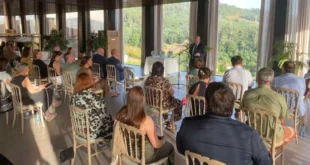
By Felice L Bedford / University of Arizona
———————————————————————————————

We found that a number of people living in parts of Mexico can be traced to a Sephardic woman. The woman appears to have come from Spain, most likely in the early 1600s at the founding of Mexican communities. She undoubtedly would have been a converso or crypto Jew, since outright practice of Judaism was forbidden even far from the homeland in New Spain. The evidence is based on an exact match in the DNA (the mitochondrial DNA, specifically) of contemporary Mexicans to known Sephardic individuals who trace their migration from Spain and Portugal to Ottoman Empire regions, including Turkey and Bulgaria. The regions of Mexico involved are Coahuila, Nuevo León, and Tamaulipas and South Texas in the United States. These are regions where there are numerous anecdotal and historical reports of Sephardic founders. Our work provides firm genetic evidence that indeed these stories are true. Moreover, it shows that Sephardic women were ancestors of the contemporary population, not just men. Genetic studies have more commonly found that European men and local women were the founders of many new communities. These regions of Mexico may be a European female founder hotspot. I like knowing that Sephardic DNA lives on, even when the people themselves do not preserve – or not even know of – their Sephardic heritage.
We have also found another Jewish signature within mitochondrial DNA, this one present in both Sephardic and Ashkenazi Jews. Our population here were Americans and strikingly, only Jewish people were found to have this variant. In addition, due to a lot of different patterns of this same basic type, the signature appears to be an ancient one that may predate the split between different Jewish groups. It may be traceable back to original Jewish tribes, if not before. It’s mind bending to imagine the DNA working its way virtually unchanged as it left the Near East and dispersed eventually throughout Europe, including Bulgaria, Romania, Czech Republic, Poland, and Russia to name some of the places where we found this signature. The variant is an unusual one found only in this group that affects the ATP or energy of cells; whether this variant gave some survival advantage to Jewish individuals who possessed it has yet to be determined.
Both of these Jewish calling-cards can be found in a very specific subclade of mitochondrial DNA known as mitochondrial haplogroup T2e. For all the fun technical and other details, please refer to the article.
————————————————————
Bedford FL, Yacobi D, Felix G, Garza FM (2013) Clarifying Mitochondrial DNA Subclades of T2e from Mideast to Mexico. J Phylogen Evolution Biol 1:121. doi: 10.4172/2329-9002.1000121
 eSefarad Noticias del Mundo Sefaradi
eSefarad Noticias del Mundo Sefaradi


Hi. I am the lead author. I can be reached at bedford@u.arizona.edu for questions and comments.
You also forgot to mention Guadalajara which also has a heavy Sephardic Jewish history and heritage. My grandpa Francisco Fajardo is a descendant from those Jews of Jalisco. Since I didn’t believe him I did a haplogroup test on him and his haplogroup was J1-m267 with the Cohen modal type whatever that is